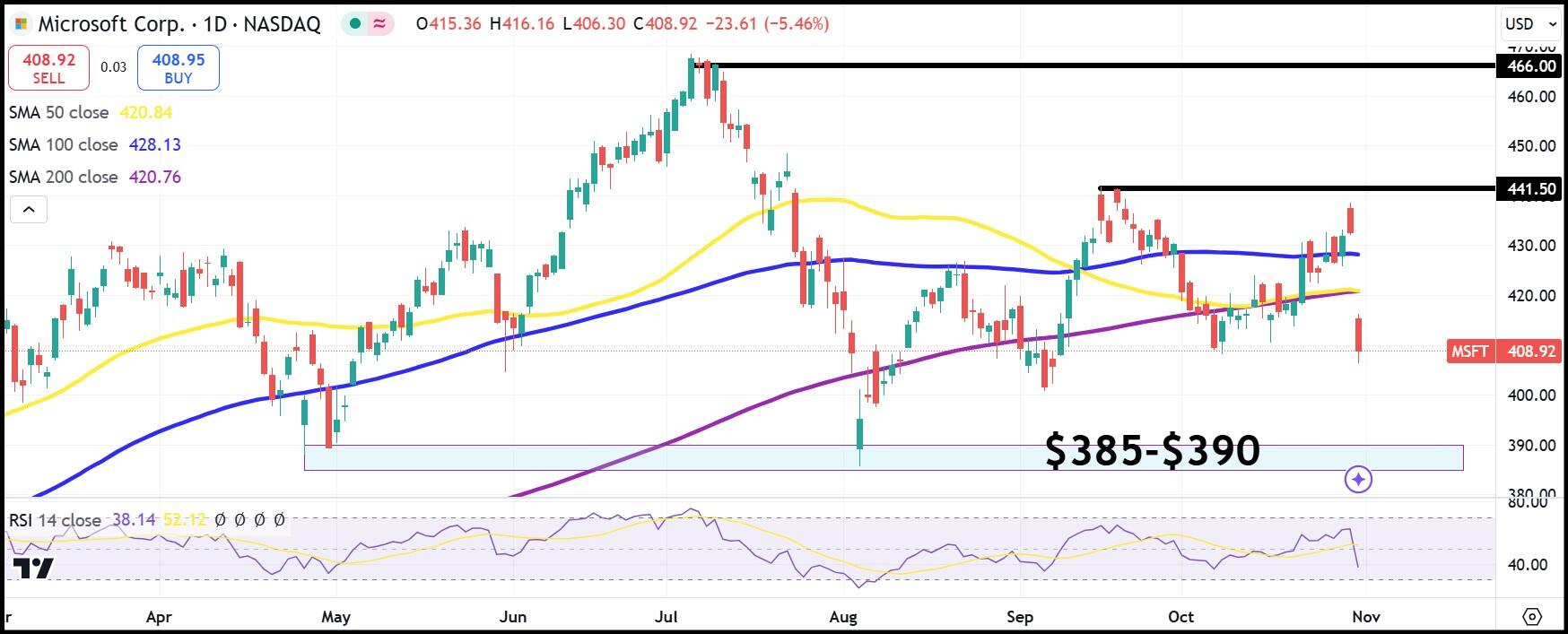- Microsoft shares fell as much as 6% on Thursday after reporting fiscal first-quarter earnings.
- CEO Satya Nadella’s company easily beat the Wall Street consensus for revenue and net income.
- GAAP EPS was up 10% year over year, and revenue was up 16%.
- MSFT stock fell due to lower projected Azure cloud growth in the second quarter.
Microsoft (MSFT) fell on Thursday following the release of last night’s earnings that showed a slightly lower forecast for Azure cloud growth in the next quarter.
Microsoft’s poor performance caused the stock to fall nearly 6% on Thursday morning, dragging down the Dow Jones Industrial Average (DJIA) with them. The Dow fell 0.66% around midday, while the NASDAQ fell a much worse 2.25%.
Microsoft earnings news
Microsoft’s stock price appears to depend entirely on how its Azure cloud unit grows. For the fiscal first quarter of 2025, which ended September 30, Azure grew its revenue 33% year-over-year or 34% in constant currency.
“At Azure, we expect second-quarter revenue growth to be 31% to 32% in constant currency, driven by strong demand for our portfolio of services,” Microsoft CFO Amy Hood said on the call. company profits.
Analysts seemed to think the sell-off allowed for a good entry point as Azure continues to grow impressively at such a high level. Additionally, the top and bottom lines showed the quality of executive team execution that the market has become accustomed to.
The Washington state company led by CEO Satya Nadella earned $3.30 per share on a GAAP basis, up 10% year over year. Operating income of $30.6 billion increased 14% year-on-year.
Revenue of $65.59 billion was more than $1 billion above the Wall Street consensus estimate and was up more than 16% from a year ago.
The Productivity and Business Processes division reported $28.3 billion in revenue, an increase of 12% year-over-year. The Intelligent Cloud segment reported $24.1 billion in revenue, an increase of 20% year-over-year. The More Personal Computing division saw $13.2 billion in sales, which represented an increase of 17%.
Microsoft, a company valued at about $3.2 trillion, paid dividends and repurchased MSFT stock for a total of $9 billion in the fiscal first quarter.
Analysts were undeterred by the sell-off. JPMorgan notably lowered its price target from $470 to $465 but maintained its Overweight rating. Barclays maintained its $475 price target and Overweight rating. The Buy rating on Jefferies was maintained, and the investment bank maintained its $550 price target. Wedbush maintained its $550 price target, and Evercore ISI maintained its $500 price target.
“We believe long-term trends in the commercial business remain intact as MSFT continues to gain cloud share and its AI services continue to scale,” said Evercore analysts led by Kirk Materne.
Microsoft Stock Forecast
Microsoft stock has already faced serious resistance at $466 and $441.50 in recent months, so it’s not surprising that MSFT requires further consolidation. Nobody questions the value of Microsoft, but they do question its valuation. Microsoft was already trading at 32 times fiscal 2025 EPS, so a pullback is perhaps what the stock requires right now.
Additionally, the October Non-Farm Payrolls number is released on Friday, and next Tuesday the US elections are held. Nervous institutional investors may want to hold cash until these events have passed.
Clear support for MSFT lies in the $385 to $390 range that held in April and again during the August 5 crash. However, many traders will see Microsoft stock trading at a discount of $25 and will start buying this week.
However, it looks bad that MSFT’s 200-day SMA is about to break below the 50-day SMA in what would be called a bearish death cross. Both moving averages are cruising near the $420 mark on Thursday.
MSFT Stock Daily Chart
Source: Fx Street
I am Joshua Winder, a senior-level journalist and editor at World Stock Market. I specialize in covering news related to the stock market and economic trends. With more than 8 years of experience in this field, I have become an expert in financial reporting.








